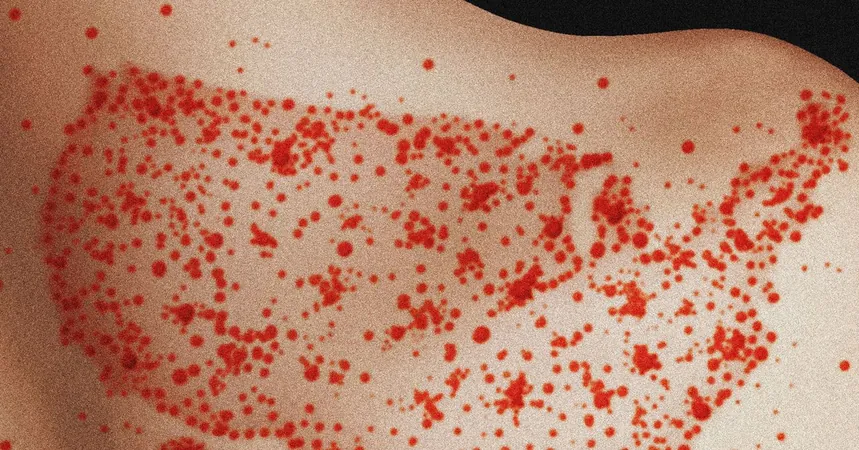
Alert: Measles Could Make a Comeback in the US Within 20 Years!
2025-04-24
Author: William
Are We on the Brink of a Measles Epidemic?
In a startling development, recent research suggests that measles, once declared eliminated in the United States back in 2000, may soon reestablish itself as a regular presence if current vaccination trends continue. With declining vaccination rates among kindergartners and controversial political pushes to alter the childhood vaccine schedule, experts from Stanford University warn that the nation could see a dramatic surge in measles cases over the next 25 years.
Shocking Predictions from Stanford's Latest Study
Utilizing sophisticated computer modeling, the study indicates an alarming possibility: if vaccination rates remain stagnant, the country could face upwards of 850,000 measles cases, 170,000 hospitalizations, and 2,500 deaths by 2048. An astonishing 83% of simulation scenarios pointed toward measles becoming endemic. As Jeffrey Griffiths, a Tufts University public health expert, bluntly states, "Measles is very likely to become endemic quickly if we continue in this way."
Texas Outbreak: A Wake-Up Call
The urgency of this situation is underscored by a current measles outbreak in Texas, which has reported over 600 cases—the most since 1992—along with 64 hospitalizations and two tragic deaths. This epidemic threatens the very status of measles elimination previously achieved. The nationwide total of 800 cases in 2025 already marks the highest number since 2019.
Declining Vaccination Rates: A Concerning Trend
Data from the CDC reveals a troubling trend: vaccination coverage among kindergarteners has dipped from 95% in 2019–2020 to about 93% in 2022–2023. Key vaccines such as MMR (measles, mumps, and rubella) and DTaP (diphtheria, tetanus, and pertussis) are seeing decreased uptake, raising alarms among health professionals.
The Science Behind the Predictions
The Stanford team analyzed state-specific vaccination rates and numerous variables to understand each state's vulnerability to outbreaks. They found that, even at a modest 10% decline in measles vaccinations, projected cases could skyrocket to 11.1 million in 25 years, while a mere 5% increase in vaccinations could significantly cut cases down to just 5,800.
What Lies Ahead for Other Diseases?
While the study highlighted measles, it also examined the risks of rubella, polio, and diphtheria. Thankfully, these diseases appear less likely to become endemic, as vaccination rates would need to see drastic declines for that to occur. However, as Stanford's Nathan Lo warns, "Any of these diseases, under the right conditions, could come back."
Mitigating Factors and Community Actions
Importantly, the study's model assumes uniform vaccination rates within states, overlooking localized pockets with significantly lower rates, like the Mennonite community in West Texas, which could become hotspots for larger outbreaks. Experts urge that while the full consequences of decreased vaccination may not be felt immediately, the eventual ramifications could be dire, and it’s crucial to address vaccine hesitancy now.
Call to Action: Don’t Let History Repeat Itself!
As we stand on the precipice of a potential public health crisis, experts emphasize the importance of ramping up vaccination efforts. Mathew Kiang from Stanford warns, "It’s important to note that vaccinations could drop and nothing happens for a little while. But eventually, these things are going to catch up to us." It's time for communities to take decisive action to ensure the safety of our children and prevent the resurgence of preventable diseases.









 Brasil (PT)
Brasil (PT)
 Canada (EN)
Canada (EN)
 Chile (ES)
Chile (ES)
 Česko (CS)
Česko (CS)
 대한민국 (KO)
대한민국 (KO)
 España (ES)
España (ES)
 France (FR)
France (FR)
 Hong Kong (EN)
Hong Kong (EN)
 Italia (IT)
Italia (IT)
 日本 (JA)
日本 (JA)
 Magyarország (HU)
Magyarország (HU)
 Norge (NO)
Norge (NO)
 Polska (PL)
Polska (PL)
 Schweiz (DE)
Schweiz (DE)
 Singapore (EN)
Singapore (EN)
 Sverige (SV)
Sverige (SV)
 Suomi (FI)
Suomi (FI)
 Türkiye (TR)
Türkiye (TR)
 الإمارات العربية المتحدة (AR)
الإمارات العربية المتحدة (AR)